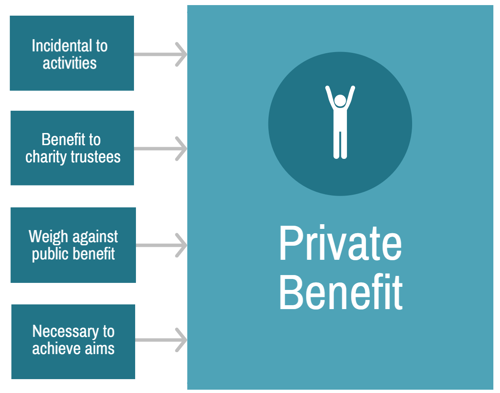Private benefit
When we decide if an organisation provides public benefit, we must look at:
- whether anyone benefits from the organisation as a private individual other than as a member of the public (this is private benefit)
- how this private benefit compares to any public benefit the organisation provides.
If it appears that the organisation has been set up wholly or mostly for the private benefit of an individual or group of people, it is unlikely that it will pass the charity test.
What do we mean by private benefit?
Individuals can, do, and should benefit from the activities of charities. However, where individuals, other than as a member of the public, benefit from a charity’s activities, we will regard this as private benefit.
The fact that some private benefit exists does not on its own mean that an organisation will fail the charity test. We look at the private benefit in the context of the whole benefit the organisation provides, or (in the case of applicants) intends to provide in pursuit of its purposes.
To pass the charity test any private benefit must be incidental to the organisation’s activities that advance its purposes:
- incidental means that the private benefit is a necessary result or by-product of the organisation’s activities and is not an end in itself.
We must make a judgement on the balance between the private benefit and the public benefit resulting from the activities of an organisation. If the private benefit is not incidental to the activities in pursuit of the organisation’s purposes, then we need to consider whether the charity is being set up or run for the private benefit of individuals.
For example, a heritage charity plans to use its funds to restore a historic mill belonging to a private individual. The owner will benefit from the value added to his property from this activity.
In this case, we would look for reassurances that firm arrangements were in place to make sure that the private benefit to the owner is removed or minimised. Examples of this would be a firm undertaking to transfer ownership to the charity or for it to take a long-term lease of the property. Whatever action the charity took, it would need to make sure that any private benefit is outweighed by the public benefit from continued access to the property and use for charitable purposes. Where this is not possible, and the private benefit appears to be the real purpose rather than being incidental, the organisation may fail the charity test.
What is incidental private benefit?
Private benefit is incidental when it is a by-product of the provision of benefit in pursuit of a charity’s purpose and not a purpose of the charity itself.
A common example of incidental private benefit is a charity with paid staff. There is private benefit to the staff, but if the charity cannot operate on a purely voluntary basis, then paying suitable staff at a reasonable rate is necessary to the pursuit of its purposes.
In some cases, it will not be clear that paying a salary or providing some other benefit to a particular person is necessary to let the charity achieve its aims. In those cases, we need to consider if the private benefit is incidental or whether the charity has been set up for the benefit of that person.
Where a charity has members, and the members get particular benefits from the charity, we need to be satisfied that those benefits are incidental to the purpose of the charity. Benefits that are trivial or of little value will usually be considered as incidental.
Members of a charity can also be the main people who benefit from its activities (for example Girl Guides, Scouts or similar groups). Where a charity directs benefit at its membership, we need to consider how far there is public access to that membership. Any criteria for membership must be justifiable and reasonable bearing in mind the charity’s purposes. If a charity exists primarily to benefit its members and it has a closed or unduly restricted membership, then its ability to provide public benefit will be in doubt.
For example, a professional body that provides training and improves the standards and status of their profession, will benefit its membership. If the organisation can demonstrate that the focus of its activities is towards the indirect benefit to the public through the maintenance of high professional standards and practice, then the private benefit to the members may be regarded as incidental.

When is private benefit not incidental?
One example is where the main beneficiaries of a charity are its members, and all the members are also charity trustees (and there are no other potential members or beneficiaries). The charity then exists for self-interest or private benefit only and not public benefit.
We have particular concerns where the charity trustees of a charity are the people benefiting from it as private individuals, or where those benefiting most are people connected with the charity trustees such as family members or companies in which the trustees have an interest.
In any case where a charity trustee is remunerated for services provided to the charity (including an honorarium), the other charity trustees must make sure that the remuneration conditions set out in the 2005 Act are met.
How we make our decision
We make a judgement on the whole picture of public benefit in the organisation being looked at, including:
- the balance of public benefit and private benefit
- the balance of public benefit and disbenefit
- whether any condition on accessing the benefit is unduly restrictive.
We do this based on all the facts and circumstances applying to the organisation.
